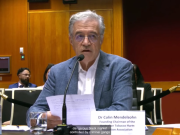A meta-analysis of 38 studies by the University of California San Francisco concludes that e-cigarettes are associated with significantly less quitting among smokers, as currently being used [1].
Surprising results

The authors, Sara Kalkhoran and Stanton A. Glantz, screened smoking cessation related publications over PubMed and Web of Science around mid-2015 and exploited, over the 577 hits, the 38 most pertinent publications where the use of e-cigarettes was included in the protocol.
Their results indicate (1) that quitting rates were significantly lower (28%) among smokers using e-cigarettes compared to those not using it, and (2) that smokers were not necessarily interested in smoking cessation when using e-cigarettes.
Public health professionals react

The findings of this study shocked public health professionals and appealed to many reactions by international experts from the USA and from the UK where the use of e-cigarette is currently promoted by NHS, along with nicotine patches and other gums, as an aid to smoking cessation.
Professor Robert West, Professor Ann McNeill, Professor Peter Hajek, Professor Linda Bauld of Cancer Research UK and Roseanna O’Connor of Public Health England are unanimous in their comments of the study and point out the success of smoking reduction in the UK that coincides with a growing popularity of the e-cigarette. At the European level, Dr Konstantinos Farsalinos re-analyzed the Eurobarometer’s data and showed a comparable success of the e-cigarette against the tobacco one.
Clive Bates is also critical towards the actual and a former version of Kalkhoran and Glantz’s manuscript, asserting that the scientific journal (in fact its editors) “has been duped into publishing a ‘meta-analysis’ of e-cigarette studies.
To what does a meta-analysis refer?
And the shortcut of using meta-data analysis to identify drivers or as a decision tool for agencies is tempting since they are supposed to aggregate the findings of many other researches. But things are not that easy.
In our case, the meta-analysis re-processes the results and discards all the precious comments and self-critics the authors have made on their findings, the limitations that they identified compared to other findings. It is like getting rid of the expertise of each professional, of the sensitivity that exudes from a scientific paper when it is presented with honesty.
About the authors

Dr Sara Kalkhoran, MD, has been the author of several publications various domains from AIDS education in Iran, nodular melanoma, indoor air policy, secondhand smoke exposure to e-cigarettes.
She collaborated with the senior author, S. Glantz, on 4 occasions in the last 2 years. Their last article [2] is the sensitivity analysis of a mathematical model that describes the cost/benefit on health of increasing e-cigarette promotion.
They conclude in a potential for e-cigarette harmfulness in the current context of uncertainty about the health risks, increasing e-cigarette use among youth, and the varying health effects at different e-cigarette health costs.

Prof Stanton A. Glantz is a professor medicine at the University of San Francisco, director of the UCSF Center for Tobacco Control Research and Education, and he made several contributions to the domains of secondhand smoking and tobacco control.
His numerous publications (books, peer-reviewed articles, grey literature) and actions attest to his engagement against the tobacco industry, not only in California, where he lives and works, but also on an international level. He is taking a clear position against the e-cigarette that he found is “aggravating rather than ameliorating the tobacco epidemic among youths” [3]. He received federal fundings ($20-million) as the principal investigator for a 5-year program aiming at helping the FDA better support sensible regulation.
Update: January 18, 2016
During 30 minutes on the Californian KQED radio, Prof Glantz and Gregory Conley, President of the AVA, debated on topics related to the present study.
California, a battleground for the anti-smoking groups and the tobacco industry

In California, considered exemplarily strict on smoking, regulation has strengthened with years since 1995, when it became the first State to impose a ban on tobacco cigarettes. It is also the battleground for the war between health groups and the tobacco industry.
This strictness has spread on vaping products against which advertising campaigns ($7-million) were launched last year, warning about health hazards by the California Department of Public Health. In focus, the prevention of the youth with regard to the attractiveness of the device that may become a gateway to tobacco cigarettes.
The controversy in its context
The controversy comes from the fact that smokers who may pay attention to this study are allowed to think that e-cigarettes are useless in their attempts to quit, which is for many experts a wrong interpretation. The controversy could even reach higher levels if an official agency makes a similar interpretation.
We can however easily understand such controversial conclusions in the context of a research carried out on federal funds in a State that can be considered the showroom for extreme (visionary?) regulation attempts. Such considerations are addressed by D. Sweanor for whom scientists are also businessmen handling millions of dollars in contracts to fund their research where “good conclusions” are rewarded by the renewal of contracts. Californian science has also recently demonstrated a huge potential for controversies, giving strength to vaping advocates, and it is probably not the end of the story…
[1] Kalkhoran, S., & Glantz, S. A. (2016). E-cigarettes and smoking cessation in real-world and clinical settings: a systematic review and meta-analysis. The Lancet Respiratory Medicine, 4(2), 116-128.
[2] Kalkhoran, S., & Glantz, S. A. (2015). Modeling the health effects of expanding e-cigarette sales in the United States and United Kingdom: a Monte Carlo analysis. JAMA internal medicine, 175(10), 1671-1680.
[3] Dutra, L. M., & Glantz, S. A. (2014). Electronic cigarettes and conventional cigarette use among US adolescents: a cross-sectional study. JAMA pediatrics, 168(7), 610-617.











